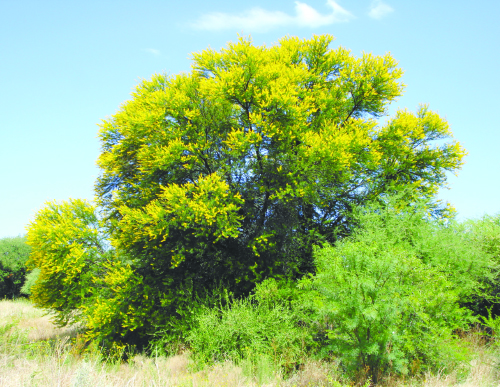Luise HoffmannThis tree is now conspicuous by being covered in golden-yellow, ball-shaped flowers. It is particularly common and obvious along river banks and wherever there is shallow groundwater.
Name: A. Soetdoring G. Weißdorn H. orusu; N/D //khûs. The botanical name karroo refers to the fact that this tree is very common throughout Southern Africa, particularly in the Karoo.
The sweet thorn occurs very wide spread in southern and central Namibia up to the vicinity of Tsintsabis. It is found in certain parts of the Kunene region but is absent from the Namib, the eastern Kalahari and north-eastern Namibia.
It usually is an erect, single-stemmed tree, up to 15 m high, with a well developed crown and dark red-brown to black rough bark. Young branches are rust-red.
The German name “Weißdorn” meaning ‘white thorn’, refers to the straight, long and sharp, white spines, which are paired and may reach 7 cm in length. The twice divided dark green leaves are shiny and hairless on both surfaces. Usually there is at least one pale brown, egg-shaped gland on the grooved leafstalk.
At this time of the year the golden-yellow, sweetly scented ball-shaped flowers are this tree’s most visible feature. The tree may flower several times during the rainy season (October – February) and produces large amounts of nectar and pollen, attracting bees and other insects.
Slender, red-brown, sickle shaped pods, slightly constricted between the seeds, grow in bunches from January onwards.
The sweet thorn is an excellent fodder tree as its leaves, flowers and pods are eaten by game and livestock. Young leaves do not contain prussic acid as those of many other acacias do and are therefore eagerly browsed.
The bark is used for tanning, giving the leather a reddish colour. It is also used to dye fabric resulting in a yellow to brown colour and it may be used for cordage. When the bark is damaged the tree exudes copious amounts of a clear golden to reddish gum which is edible and sweet, hence the English and Afrikaans common names. It is relished by children, bush-babies and monkeys. It is practically indistinguishable from gum arabic, and like the latter is used in the confectionery and ice-cream industry as well as the pharmaceutical industry.
When I was a child my parents sent me to collect the gum from the sweet-thorn trees on our farm. We put it in a small glass bottle, added some boiling water and after about a day it had dissolved to make a very satisfactory paper glue.
A tea of the bark alleviates diarrhoea. A pulp prepared by mixing the sweetly scented flowers and buds with hot water is used as a blistering plaster on boils and abscesses. This pulp can also be used to treat a sprained limb. `
The sweet thorn is easily grown from seed soaked in hot water. Frost- and drought resistant, it grows fast into a beautiful shady tree. However, it only lives for about 30 to 40 years. Seedlings are available from the Directorate of Forestry’s nurseries or from the nursery of the National Botanical Research Institute, Tel 061 202 2014.
Stay informed with The Namibian – your source for credible journalism. Get in-depth reporting and opinions for
only N$85 a month. Invest in journalism, invest in democracy –
Subscribe Now!






